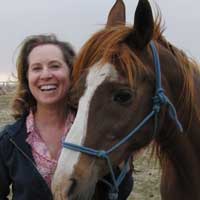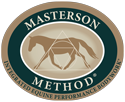
Leah’s original motivation for learning The Masterson Method® was to maintain her horse’s comfort level as he aged. He has moved fairly well over the past 12 years that she’s been riding him, but she knew from her own personal experience that we all accumulate aches and restrictions as we get older. Most riders dream of riding horses that move so freely it feels as if you’re floating. Her personal experience with massage, passive stretching (Yin Yoga), and guided movement and release of unnecessary muscle tension (Alexander Technique) leads her to believe that there are benefits to be gained from applying a combination of similar-types of approaches for increasing range of motion within horses. She has been an equestrian client of an Alexander practitioner (Jerald Schwiebert) who assists a variety of athletes, performers, and physical therapy patients. Increased freedom of movement that can be directly experienced (by ice skaters, dancers, equestrians, etc.) or observed (by acting directors) motivates Jerry’s clients (including herself) to return for more sessions. She has also learned from practicing The Masterson Method® that it is very effective to choose what bodywork protocol works best for the horse based on continuous reading of their feedback. She has been delighted to learn from Jim that only minimal guidance and pressure are required to bring awareness to a tight junction, how to read subtle feedback signals from the horse, and that it is often easy to convince a relaxed horse to release tense muscles themselves. Relaxation of unnecessarily tense muscles in both rider and horse leads to an improved riding experience and horse’s health.
Her motivation to continue learning more about The Masterson Method® and become a certified practitioner has expanded to include learning more about equine physical therapy. As a veterinarian, she believes that this approach can facilitate recovery from some types of injury and improve chronic range of motion limitations. Sometimes it is easy to forget that horses are extremely sensitive, alert animals and applying relatively high degrees of pressure or joint movement may lead to overall opposition and rigidity. For the purpose of evaluation, the horse’s natural, guarded response may be misinterpreted and lead to confusion about the degree and source of any limitation. She believes an abundance of useful information about a horse’s functional status gathered during a complete bodywork session can be used to accurately assess the current status and monitor recovery.
